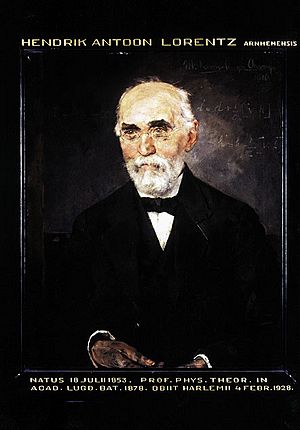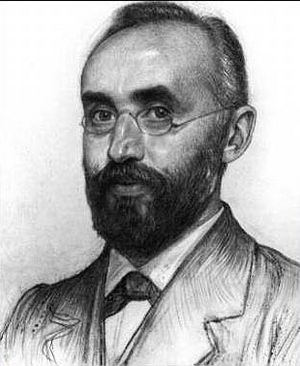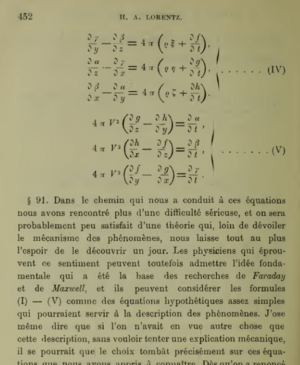Hendrik Lorentz facts for kids
Quick facts for kids
Hendrik Lorentz
|
|
|---|---|
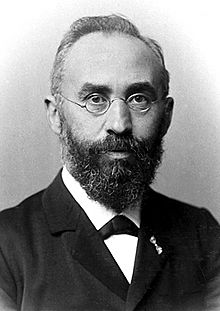
Lorentz in 1902
|
|
| Born | 18 July 1853 Arnhem, Netherlands
|
| Died | 4 February 1928 (aged 74) Haarlem, Netherlands
|
| Alma mater | University of Leiden |
| Known for |
|
| Awards |
|
| Scientific career | |
| Fields | Physics |
| Institutions | University of Leiden |
| Doctoral advisor | Pieter Rijke |
| Doctoral students |
|
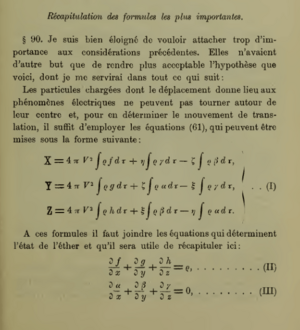
Hendrik Antoon Lorentz (born July 18, 1853 – died February 4, 1928) was a Dutch physicist. He is famous for his important work in understanding how light and matter interact. In 1902, he shared the Nobel Prize in Physics with Pieter Zeeman. They won for discovering and explaining the Zeeman effect. This effect shows how light changes when it passes through a magnetic field.
Lorentz also developed the Lorentz transformation. This set of equations helps explain how space and time change for objects moving very fast. Albert Einstein later used these ideas in his special theory of relativity. Lorentz also described the Lorentz force, which is the combined electric and magnetic forces on a charged particle. He was a leading figure in physics and helped set the stage for quantum theory. He received many awards and was even chairman of a group that later became UNESCO.
Contents
Biography
Early Life and Education
Hendrik Lorentz was born in Arnhem, Netherlands. His father was Gerrit Frederik Lorentz, a successful gardener. After his mother died, his father remarried. Hendrik was a very bright student. From 1866 to 1869, he attended a new type of public high school. He was excellent in science, math, and languages like English, French, and German.
In 1870, he passed the exams needed to get into university. He then studied physics and mathematics at Leiden University. A professor named Frederik Kaiser greatly influenced him there. This led Lorentz to become a physicist. After getting his first degree, he taught math at night school. But he also kept studying at Leiden. In 1875, he earned his doctoral degree. His work was about how light reflects and bends. He improved on the ideas of James Clerk Maxwell.
Career as a Professor
Becoming a Professor in Leiden
In 1877, when he was just 24, Lorentz became a professor. He got a new position in theoretical physics at the University of Leiden. He gave his first lecture in January 1878. It was about "The molecular theories in physics." In 1881, he became a member of the Royal Netherlands Academy of Arts and Sciences.
For his first 20 years in Leiden, Lorentz focused on electromagnetism. This field studies how electricity, magnetism, and light are connected. Later, he explored many other areas of theoretical physics. He made big contributions to how fluids move and to general relativity. His most important work was in electromagnetism, electron theory, and relativity.
Lorentz believed that atoms were made of tiny charged particles. He thought that the movement of these particles created light. In 1896, his former student, Pieter Zeeman, found the Zeeman effect. This proved Lorentz's idea. Lorentz then explained why this effect happened. For their combined work, they won the Nobel Prize in Physics in 1902. Many scientific ideas are named after Lorentz today. These include the Lorentz–Lorenz equation and the Lorentz force.
Understanding Electrodynamics and Relativity
Lorentz studied how light moves in different situations. He looked at how light travels when things are moving very fast. In 1892 and 1895, he found a way to simplify these movements. He used a new idea called local time. This "local time" depended on both universal time and the location.
Even though Lorentz didn't fully explain what local time meant, it helped him explain some puzzles. For example, he could explain the aberration of light. This is how the apparent position of stars changes due to Earth's motion. He also explained the Fizeau experiment, which measured the speed of light in moving water.
In 1892, Lorentz also suggested that moving objects get shorter in the direction they are moving. This idea is called length contraction. Another scientist, George Francis FitzGerald, had thought of this too. Later, in 1899 and 1904, Lorentz added time dilation to his equations. This means time itself can slow down for moving objects. These equations became known as the Lorentz transformations.
Lorentz and Special Relativity
In 1905, Albert Einstein used many of Lorentz's ideas. Einstein wrote his famous paper on the special theory of relativity. Because Lorentz laid the groundwork, this theory was first called the Lorentz–Einstein theory.
Lorentz continued to publish papers about "Einstein's principle of relativity." He also gave credit to Henri Poincaré for his contributions to relativity.
Lorentz and General Relativity
Lorentz was one of the few scientists who supported Einstein's work on general relativity from the start. He wrote several papers and discussed his ideas with Einstein. He tried to combine Einstein's ideas with other physics principles.
Lorentz and Quantum Mechanics
In 1926, Lorentz gave lectures at Cornell University. He talked about the new field of quantum mechanics. He presented Erwin Schrödinger's wave mechanics, which describes how tiny particles behave.
Changes in His Career and Public Service
New Priorities
In 1910, Lorentz decided to change his work life. His teaching and managing duties at Leiden University took up too much time. He wanted more time for research. So, in 1912, he left his full-time professor job. He became a curator at the "Physics Cabinet" at Teylers Museum in Haarlem. He still taught at Leiden University as an external professor. His "Monday morning lectures" on new physics ideas became very popular.
Lorentz first asked Einstein to take his old job at Leiden. But Einstein had just accepted a position elsewhere. Instead, Lorentz chose Paul Ehrenfest as his replacement. Ehrenfest later founded the Lorentz Institute.
Helping the Netherlands
After World War I, Lorentz helped create a scientific committee. This group aimed to use science to solve problems like food shortages. Lorentz led this committee. While it didn't solve all problems, it did lead to the creation of TNO. This is the Netherlands Organisation for Applied Scientific Research.
Lorentz also led a government committee for a big project. This project was the Afsluitdijk (Enclosure Dam). This dam was built to control water levels in the Waddenzee. At the time, building such a large dam was new. Lorentz and his team used math and physics to predict how the dam would affect water flow. This was a huge challenge. He spent a lot of time on this problem from 1918 to 1926. The dam was finished in 1932. Lorentz's predictions were very accurate. One of the dam's locks was named after him.
Family Life
In 1881, Lorentz married Aletta Catharina Kaiser. Her father was a professor and director of a museum that later became the famous Rijksmuseum. He also designed the first postage stamps for the Netherlands. Hendrik and Aletta had two daughters and one son. Their eldest daughter, Dr. Geertruida Luberta Lorentz, also became a physicist.
Death and Legacy
Hendrik Lorentz became very ill in January 1928. He died shortly after, on February 4. His funeral procession was filmed, showing many people, including Albert Einstein and Marie Curie, attending.
Lorentz is seen as one of the most important scientists from the "Second Dutch Golden Age." This was a time around 1900 when science thrived in the Netherlands. Besides the Nobel Prize, he received many other honors. These included the Rumford Medal and the Copley Medal.
Images for kids
-
Albert Einstein and Hendrik Antoon Lorentz, photographed by Paul Ehrenfest in front of his home in Leiden in 1921.
-
Lorentz (left) at the International Committee on Intellectual Cooperation of the League of Nations, here with Albert Einstein.
-
Lorentz-monument Park Sonsbeek in Arnhem, the Netherlands
See also
 In Spanish: Hendrik Antoon Lorentz para niños
In Spanish: Hendrik Antoon Lorentz para niños
- List of things named after Hendrik Antoon Lorentz
- Lorentz oscillator model
- Lorentz covariance
- Modern searches for Lorentz violation
- Heaviside–Lorentz units
- Lorentz-violating electrodynamics
- Geertruida de Haas-Lorentz
- Lorentz (crater)
- Lorentz Medal
- Trouton–Noble experiment


